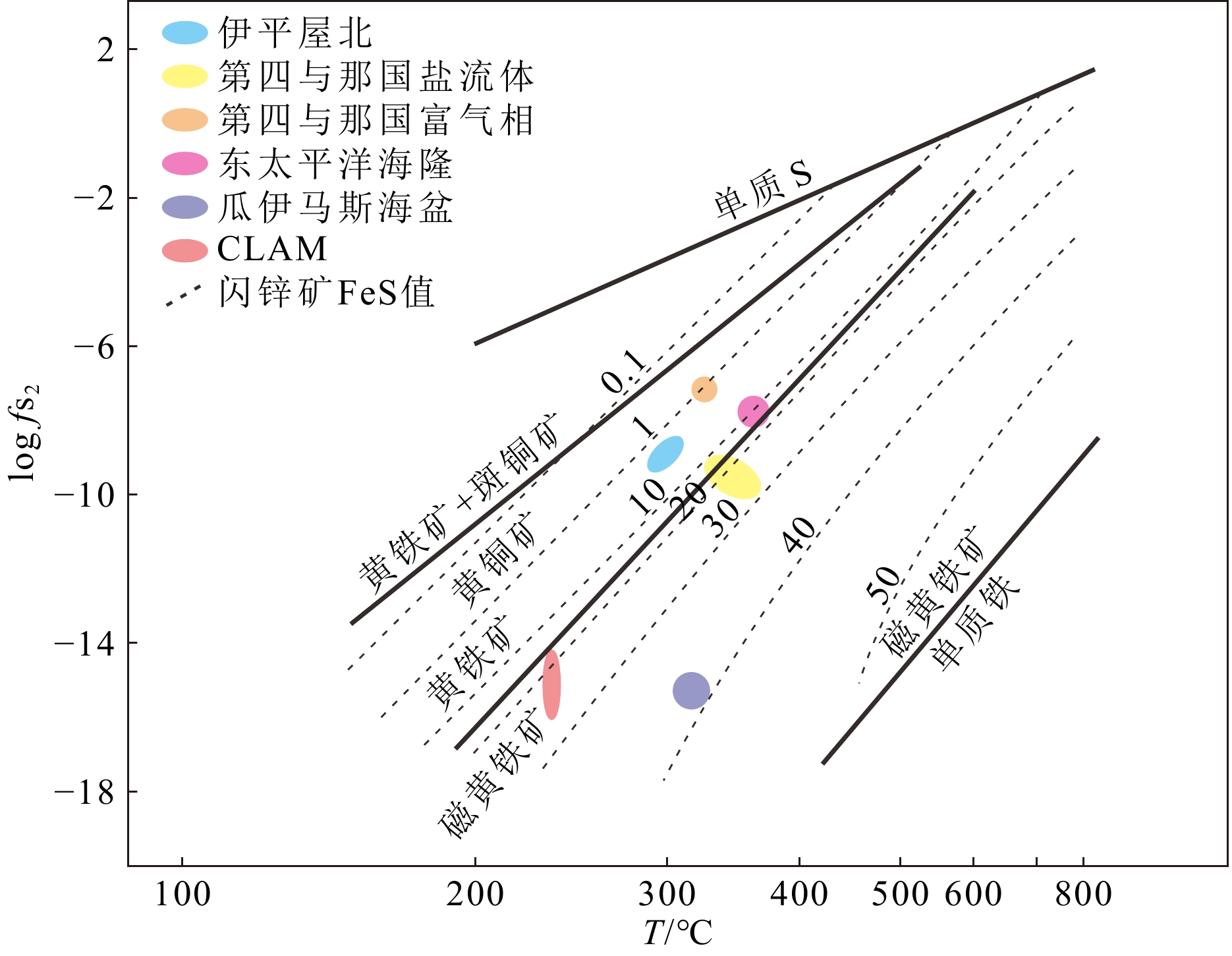Low sulfur fugacity mineralization in CLAM hydrothermal field
-
摘要: 冲绳海槽是琉球俯冲系统的重要组成部分,该区热液硫化物研究对揭示非成熟弧后盆地内部热液成矿作用特征具有重要意义。CLAM热液区位于冲绳海槽中部(27°33′N、126°58′E),大量研究表明,该区成矿作用特征与海槽其他热液区存在显著差异,但其成因尚不明确。对CLAM热液区硫化物矿物组成、共生组合关系及闪锌矿微区元素组成进行了系统分析测试,在此基础上提出,该区特殊的矿物学特征及矿物化学组成可能受热液流体硫逸度控制。本文研究样品为富Fe型块状硫化物,主要由磁黄铁矿及低温闪锌矿组成,磁黄铁矿的大量结晶暗示着该区热液流体具有低硫逸度特征。热液成矿过程中,流体温度及硫逸度经历了由低到高的演化。闪锌矿中极高的Fe含量同样受控于该区流体低硫逸度条件,计算结果表明,热液流体的硫逸度值为–15,与其他受沉积物影响的热液活动区一致。流体-沉积物反应过程中,沉积物中有机质的分解可能是导致CLAM热液区热液流体硫逸度系统性降低的主要原因。Abstract: The Okinawa Trough is an important part of Ryukyu subduction system and the sulfide research in this region is important for uncovering the hydrothermal mineralization characteristics in incipient back-arc basin. Many researches have demonstrated that the mineralization characteristics of CLAM hydrothermal system are different from those of others in Okinawa Trough. However, the cause of these differences are still unclear. The mineralogical characteristics and sphalerite in situ trace element contents of CLAM Fe-rich type sulfides are determined systematically. On these basis, we propose the unique mineralogical compositions and geochemical characteristics in CLAM are controlled by sulfur fugacity of hydrothermal fluid. The studied samples are mainly composed of pyrrhotite and low-temperature sphalerite. The occurrence of large amounts of pyrrhotite implies that the hydrothermal fluid possesses low sulfur fugacity. During the mineralization process, both temperature and sulfur fugacity conditions for the mineralization evolved from low to high. The high Fe contents also support the low sulfur fugacity condition during the CLAM sulfide mineralization. The calculation indicates that the sulfur fugacity value of hydrothermal fluid is –15, which is equal to those of other sediment-hosted hydrothermal systems. The decomposition of organism in sediments during hydrothermal circulation is the major cause of low sulfur fugacity in CLAM fluid.
-
Keywords:
- sulfur fugacity /
- hydrothermal mineralization /
- CLAM site /
- Okinawa Trough
-
自1979年在加拉帕戈斯洋脊首次发现热液活动以来,已经有超过700个热液喷口被报道。这些热液活动区主要发育于洋中脊、海底火山弧、弧后盆地等区域[1-4],对促进水圈-岩石圈物质、能量交换及维持全球化学元素平衡具有重要意义[5-6]。此外,现代海底热液活动伴生的热液硫化物中富含Cu、Pb、Zn、Au、Ag等多种成矿金属元素,具有重要的资源潜力[7-8]。因此,现代海底热液活动自发现以来便成为了科学界关注的焦点。
冲绳海槽位于东海大陆架边缘,海槽内部具有异常高的热流值,发育了大量的热液活动[9-12]。这些热液活动区主要集中于海槽中部和南部,而海槽北部热液喷口相对匮乏。作为一个尚处于扩张期的弧后盆地,冲绳海槽内部热液活动具有明显的独特性。如热液流体循环过程中普遍与上覆沉积物发生了反应,从中萃取了部分成矿金属元素,导致了硫化物中明显的沉积物组分信号[12-15];海槽南部第四与那国热液活动区发现了超临界CO2流体喷口,可能与加瓜海脊俯冲有关[16-17];海槽中部CLAM热液区发育了特有的热液碳酸盐沉积等[18]。这些特征使得冲绳海槽热液成矿作用显著区别于洋中脊及成熟弧后盆地热液区。因此,该区热液硫化物研究对揭示非成熟弧后盆地内部热液成矿机理具有重要意义。
受沉积物影响的热液活动区,热液流体一般具有较低的硫逸度[19-20]。然而,前人研究表明,尽管冲绳海槽内部具有厚层沉积物覆盖,但该区热液流体的硫逸度相对于其他沉积物覆盖的热液活动区却整体偏高,这可能与海槽沉积物中低有机质含量或较强的岩浆氧化性有关[14]。值得注意的是,CLAM热液区硫化物中有大量磁黄铁矿结晶,暗示着该区热液流体可能具有明显较低的硫逸度。此外,相比于冲绳海槽其他热液区,CLAM热液区硫化物在矿物组成及地球化学成分上具有明显的独特性,如特有的热液Mn碳酸盐的矿物。这可能与CLAM热液流体低硫逸度特征有关。然而,目前为止,科学界对CLAM区热液流体硫逸度条件的研究还十分匮乏,流体硫逸度对该区热液成矿作用的影响也尚不明确。基于目前的研究现状,本文对CLAM热液区富Fe型块状硫化物矿物学组成、共生组合关系、闪锌矿微区元素组成进行了系统分析测试,在此基础上,对该区热液流体硫逸度条件进行了探讨,并揭示了流体硫逸度对该区热液成矿的控制作用。
1. 地质背景
冲绳海槽作为琉球沟-弧-盆体系的重要组成部分,是由菲律宾海板块向欧亚板块之下俯冲而形成的弧后盆地,目前尚处于弧后扩张阶段[9, 20]。冲绳海槽由吐喀喇断裂带和宫古断裂带划分为北、中、南3个区域,不同区域岩浆作用及构造活动存在显著差异[21-23]。酸性浮岩是海槽内部分布最为广泛的火山岩,而玄武岩的分布则相对局限。海槽内部具有异常高的热流值,发育了大量的热液活动,其中为人熟知的包括Jade热液区、第四与那国热液区、唐印热液区、南奄西热液区、伊平屋北热液区、CLAM热液区等(图1)[20, 24-25]。冲绳海槽内部有厚层沉积物覆盖[26],热液流体循环过程中与上覆沉积物发生了反应,从中萃取了部分成矿金属元素,导致了该区硫化物具高放射性成因Sr、Pb同位素组成特征[13, 20]。有研究表明,冲绳海槽南部热液区硫化物S同位素的负漂可能指示了岩浆去气来源的挥发分贡献[27-28]。但由于其δ34S值相较于岩浆来源S歧化形成的硫化物明显偏高,且在部分热液区缺乏歧化作用伴生的硫酸盐矿物。因此,海槽南部硫化物低δ34S值可能反映了沉积物中生物成因S的再活化,而非岩浆来源挥发分的贡献[10, 12]。近期,有研究表明,海槽中部热液区硫化物成矿作用过程中,微生物也可能发挥了重要作用[11, 29]。
CLAM热液区位于冲绳海槽中部,于1988年9月由Shinkai 2000号深潜器在该区进行调查时发现,是冲绳海槽发现的第二个高温热液活动喷口,热液流体最高温度220℃。热液区面积较小(100 m×500 m),最大水深1 392 m[30-31]。CLAM热液区内被厚层泥质沉积物覆盖,前人研究发现该区热液流体具有异常高的碱度(10.3 mmol/kg)和NH4+、CH4、CO2含量,表明热液活动过程中,流体可能与上覆沉积物发生了反应[32]。此外,有机质参与的硫酸盐还原作用也在一定程度上提高了热液流体中NH4+及HCO3−的含量,导致了该区热液流体高碱度特征[33]。CLAM热液区发育特有的热液Mn碳酸盐沉积,可能与该区独特的热液成矿环境及流体物理化学条件有关[18]。
2. 样品与方法
本文样品于Hydrothermal of back-arc basin 第4航次(HOBAB 4)期间取自冲绳海槽中部CLAM热液区,样品类型为富Fe型块状硫化物,主要由磁黄铁矿及闪锌矿组成。样品表面部分氧化呈红褐色,新鲜面为灰黑色。样品为致密块状,无明显分层现象。取新鲜样品(去除氧化物部分)超声清洗3次,以除去海水及沉积物污染影响。随后将烘干的样品切薄片粘制于载玻片上,磨制、抛光以备镜下鉴定及电子探针分析之用。
2.1 硫化物矿物组成及共生组合关系鉴定
硫化物矿物组成及共生组合关系分析于崂山实验室海洋矿产资源评价与探测技术功能实验室完成,分析仪器为奥林巴斯透反光显微镜,物镜倍数选用4×、10×、20×。
2.2 闪锌矿电子探针分析
闪锌矿电子探针分析在中国海洋大学海底科学与探测技术教育部重点实验室进行,测试仪器为JXA-8230电子探针,仪器条件为加速电压15 kv,探针束流20 nA,束斑直径3 μm,探针分析标样为美国SPI国际标准合成矿物。为消除基体效应,我们对原始数据进行了ZAF校正,样品分析误差<2%。
3. 结果
样品TVG5-1和TVG5-3都为富Fe型块状硫化物(图2),主要由磁黄铁矿和闪锌矿组成,二者含量接近(图3)。在TVG5-3中还可见到少量黄铁矿及黄铜矿,部分交代早期结晶的闪锌矿及磁黄铁矿(图3C、D)。闪锌矿电子探针分析结果表明,该区闪锌矿具有显著高的Fe含量,其值一般>20%,且相较于TVG5-3,TVG5-1具有更高的Fe含量(表1)。TVG5-3中部分分析点位Cu含量具有异常高的测试值,伴随着极高的Fe含量,这可能反映了闪锌矿中黄铜矿包裹体的影响。这一推测与镜下鉴定结果相吻合,样品TVG5-3与TVG5-1的显著区别在于其内部有黄铜矿结晶,闪锌矿形成过程中可能包裹了一些显微颗粒黄铜矿,导致了其分析结果中Cu含量的异常高值。
表 1 冲绳海槽CLAM热液区闪锌矿电子探针分析结果Table 1. The EMPA analysis results of hydrothermal deposits from CLAM site, Okinawa Trough% ID S Zn Fe Cu Pb Co Ni 总量 FeS值 TVG5-1 35.50 42.98 20.23 0.62 — — — 99.33 22.33 34.81 43.12 20.55 1.45 — 0.04 0.02 99.99 22.70 34.72 45.36 19.00 0.07 0.02 0.15 0.01 99.36 21.05 34.86 45.08 19.32 0.13 — 0.12 — 99.55 21.39 35.56 40.21 21.74 1.52 0.07 0.05 0.08 99.23 23.91 34.71 43.48 20.13 0.22 0.05 0.08 0.05 98.70 22.24 34.42 45.15 18.91 0.46 — — 0.05 98.98 20.96 34.78 37.53 24.10 1.75 0.05 0.04 0.07 98.31 26.35 34.74 44.49 19.32 0.11 — — — 98.66 21.39 34.70 42.55 20.95 0.15 0.24 0.05 0.06 98.70 23.09 35.05 42.29 21.90 0.40 — 0.07 — 99.72 24.11 34.36 47.83 16.91 0.19 0.09 0.08 — 99.50 18.83 34.45 45.28 18.47 0.34 0.16 0.09 0.01 98.84 20.49 34.34 42.22 20.37 1.66 — 0.07 — 98.66 22.49 34.32 42.00 20.84 1.21 0.17 0.02 0.05 98.64 22.98 34.74 39.73 23.95 0.24 0.12 0.10 — 98.88 26.22 35.08 39.33 24.06 0.38 — 0.02 — 98.94 26.33 34.88 41.74 22.22 0.10 0.03 0.09 0.06 99.11 24.42 TVG5-3 34.96 30.40 25.31 6.51 0.20 — — 97.43 27.54 34.29 46.92 15.05 0.11 0.18 0.03 — 96.58 16.82 34.25 44.25 16.67 0.04 0.02 0.04 0.01 95.31 18.54 34.41 47.77 14.80 0.12 — — — 97.16 16.55 33.56 45.66 16.91 — — — 0.03 96.17 18.82 34.03 46.57 15.69 0.10 — — — 96.41 17.50 34.45 33.37 23.05 5.15 0.05 — 0.07 96.13 25.21 34.75 37.26 20.42 4.24 0.03 0.11 0.01 96.82 22.48 34.50 40.05 20.48 0.28 — — — 95.30 22.54 34.74 40.12 19.00 2.39 0.09 0.14 — 96.50 21.00 34.42 44.21 17.67 0.21 — 0.01 0.06 96.61 19.61 34.91 36.63 19.34 5.11 0.15 0.05 — 96.24 21.34 注:“—”表示测试值低于仪器检出限。 4. 讨论
4.1 硫化物矿物组成及共生组合关系
热液硫化物的矿物组成及共生组合关系对其成矿条件及成矿作用过程具良好的指示意义,是热液硫化物研究中常用的示踪手段[34-36]。本节内容在CLAM热液区硫化物样品矿物组成及共生组合关系系统分析基础上,揭示了该区热液成矿条件及成矿流体性质演化。
CLAM热液区TVG5-1硫化物样品主要由磁黄铁矿和闪锌矿组成,二者含量大致相等。磁黄铁矿主要呈自形板柱状晶形产出,粒度一般>100 μm,并被后期结晶的闪锌矿部分交代(图3A、B)。闪锌矿主要呈他形结构产出,且孔隙度较高,偶见与他形黄铁矿(低温结晶产物)共生,暗示其为相对低温条件下快速结晶的产物。TVG5-3样品矿物组成及共生组合关系与TVG5-1基本相似,但磁黄铁矿含量相对较高。此外,在该样品中发现了少量黄铜矿,沿着磁黄铁矿及闪锌矿边缘结晶,形成了特有的“黄铜矿镶边结构”(图3C、D)。黄铜矿形成温度一般高于300℃[35-36],TVG5-3中黄铜矿的结晶表明该区硫化物成矿作用过程中热液流体经历了明显的升温过程。在TVG5-3中,还观察到了少量黄铁矿,主要呈自形立方体结构产出,部分交代了前期结晶的磁黄铁矿(图3D)。自形立方体状黄铁矿在温度高于350℃或低于200℃条件下均可产出 [20, 35],由于其与高温黄铜矿同期产出,可据此判断其结晶温度应>350℃。前人研究表明,冲绳海槽热液硫化物矿物组成以方铅矿、黄铁矿及闪锌矿的大量结晶为主,表现出沉积物及酸性岩为主要成矿物质来源控制下的Pb-Zn富集特征[34, 36-38]。而CLAM热液区硫化物矿物组成与海槽其他热液区存在显著差异,以磁黄铁矿的大量结晶为主要特征。CLAM与海槽其他热液区硫化物截然不同的矿物组成及共生组合关系暗示着其成矿流体物理化学条件的差异。磁黄铁矿是典型的低硫逸度条件下结晶的矿物[14, 39-40],CLAM热液区硫化物中磁黄铁矿的大量结晶表明该区热液流体具有显著低的硫逸度。前人研究表明,在有沉积物覆盖的热液活动区,热液流体一般具有显著偏低的硫逸度[19],这可能与沉积物中有机质的分解作用有关[41]。CLAM热液区内有厚层沉积物覆盖,有证据表明,热液循环过程中流体与上覆沉积物发生了反应[32],这可能是导致该区流体硫逸度降低的主要原因。
综上所述,冲绳海槽CLAM热液区硫化物成矿作用过程中热液流体经历了显著的升温过程,该区热液流体具有显著偏低的硫逸度,可能受控于该区流体-沉积物反应过程。
4.2 闪锌矿Fe含量对成矿作用条件的指示
闪锌矿是热液硫化物中的常见矿物,其Fe含量对热液流体物理化学条件变化十分敏感,常用来示踪热液成矿条件[19-20, 35]。研究表明,闪锌矿中Fe的含量变化主要受控于热液流体硫逸度(fS2)及流体温度的变化[19],且与流体中Fe含量关系不大,流体温度的升高或硫逸度的降低都会促进闪锌矿中Fe对Zn的类质同象替代,从而导致其Fe含量升高。在没有沉积物覆盖的热液活动区,闪锌矿中Fe的含量变化主要受闪锌矿结晶温度控制,二者存在很好的线性相关关系。Keith 等[19]据此提出了一个经验公式来计算闪锌矿结晶温度:Fe/Zn闪锌矿=0.0013T–0.2593。而在有沉积物覆盖的热液活动区,流体-沉积物反应会导致热液流体硫逸度系统性地降低,从而导致形成的闪锌矿具有极高的Fe含量(一般>15%[19-20])。
电子探针分析结果表明,CLAM热液区闪锌矿具有极高的Fe含量(14.80%~25.81%),假若其受热液流体温度控制,那么依据Keith 等 (2014)给出的经验公式,如此高的Fe含量对应的闪锌矿结晶温度为438~840℃,这一范围远超海底热液成矿作用温度的正常值,显然是不现实的。同时,如此高的温度也与该区闪锌矿为低温条件结晶的结论(见4.1节)相矛盾。因此,笔者认为,CLAM热液区闪锌矿中极高的Fe含量并非受控于闪锌矿结晶温度,而是反映了该区流体异常低的硫逸度条件。流体沉积物反应可能是导致该区流体硫逸度降低的主要原因。为了验证这一猜想,我们对闪锌矿FeS值(FeS摩尔百分含量)进行了计算(表1),并假定闪锌矿结晶温度与该区热液端元流体一致(220℃[30-31],由于闪锌矿为该区硫化物中的主要成矿矿物,是主体成矿阶段的产物,故作此假定),进而对闪锌矿结晶时热液流体的硫逸度条件进行了判定。结果表明,CLAM热液区闪锌矿结晶过程中流体硫逸度值(log $f_{{\rm S}_2} $)约为−15,显著低于洋脊及成熟弧后盆地热液区流体硫逸度(log $f_{{\rm S}_2} $=−10[42-43]),且与受沉积物影响的瓜伊马斯海盆热液区流体硫逸度相当[42](log $f_{{\rm S}_2} $=–15~–16,图4)。值得注意的是,冲绳海槽其他热液区流体硫逸度相对CLAM热液区明显偏高(log $f_{{\rm S}_2} $=–12~–8[14, 44],图4)。这一结果与海槽其他热液区硫化物中未见大量磁黄铁矿结晶的现象一致[20]。尽管这些热液区流体循环过程中也与上覆沉积物发生了反应,但这一过程似乎并未对其流体硫逸度造成显著影响。Suzuki等[14]认为,这可能与冲绳海槽沉积物中有机质含量偏低或该区岩浆更加氧化有关。CLAM热液区与伊平屋北热液区邻近,其基底岩浆作用性质一致,但伊平屋北热液区流体却并未表现出低硫逸度特征(图4)。因此,笔者认为岩浆氧化性差异不是导致CLAM热液区低硫逸度特征的主要原因。CLAM热液区上覆沉积物中高含量有机质在流体-沉积物反应过程中分解可能是导致该区流体硫逸度系统性降低的主要原因。但具体是什么原因导致了CLAM热液区沉积物独特的高有机质含量,本研究并不能给出确切的答案,可能与该区沉积物特定的物源有关,也可能与区内高生物活动性及生产力有关。近期有研究提出,冲绳海槽Iheya热液活动区(CLAM热液区为该区内典型热液喷口)与海槽西侧槽坡冷泉系统之间存在相互作用,冷泉系统可能对Iheya热液区存在CH4等有机质贡献[45],这可能也在一定程度上导致了CLAM热液区流体的低硫逸度特征。考虑到冲绳海槽中部物源主要来源于东海大陆架物质的输入,CLAM热液区存在特定富有机质组分物源的可能性并不是很大。因此,该区高生物活动性及西侧槽坡冷泉系统的有机质贡献可能是导致区内沉积物中有机质含量显著提升的主要原因。由于高生物活动性及冷泉系统对CLAM热液区的贡献都有明显的区域性及特异性特征,这解释了为什么在如此狭窄的海槽内部会发育有明显区别于其他热液系统的CLAM热液区。总之,矿物学及闪锌矿微区元素组成都表明CLAM热液区热液流体具有极低的硫逸度,但其成因尚不明确,需要更系统的硫化物同位素地球化学、沉积物地球化学研究来加以解释。
4.3 CLAM热液区低硫逸度热液成矿
热液流体硫逸度对硫化物矿物组成及地球化学特征具有重要影响:一方面,不同硫逸度条件下结晶的硫化物矿物组成及共生组合关系会存在显著差异,如黄铁矿、黄铜矿主要在高硫逸度条件下结晶,而磁黄铁矿则在低硫逸度条件下大量产出[14];另一方面,硫逸度会对硫化物矿物化学特征产生显著影响,如黄铁矿Co、Ni含量会受到硫逸度的控制,高硫逸度条件下Ni对黄铁矿中Fe的类质同象替代会明显增强,从而导致黄铁矿Co/Ni比值降低[46]。此外,闪锌矿Fe含量也会受到硫逸度的显著影响,低硫逸度条件下结晶的闪锌矿一般具有极高的Fe含量[19]。热液条件下,流体沉积物反应过程中有机质的分解是导致流体硫逸度降低的主要原因[14]。CLAM热液区热液流体中高NH4+和CH4表明热液循环过程中与上覆沉积物发生了反应[32],导致了沉积物中有机质的分解,这使得该区热液流体硫逸度发生了显著降低,磁黄铁矿及高Fe闪锌矿大量结晶。热液成矿作用早期,流体温度较低,以磁黄铁矿及低温闪锌矿的结晶为特征。随着成矿作用进行,流体温度明显升高,高温黄铁矿及黄铜矿开始结晶,并部分交代早期结晶的低温矿物。此外,硫化物矿物组成由雌黄铁矿向黄铜矿+黄铁矿的转变表明成矿作用过程中流体硫逸度经历了由低到高的转变。前人研究发现,与海槽其他热液区相比,CLAM热液区成矿作用特征具有明显的独特性,如该区热液流体具有极高的碱度[33],特有的热液碳酸盐的发育[18]及硫化物低3He/4He比值[30]等,这可能同样部分受控于CLAM热液区特殊的低硫逸度条件。尽管本研究对CLAM热液区沉积物中有机质含量相对海槽其他热液区明显偏高的原因尚不能给出明确的解释,但却从流体硫逸度的角度对该区成矿作用的特殊性做出了回答,同时为非成熟弧后盆地内部热液成矿作用的复杂性提供了新的佐证。
5. 结论
(1)CLAM热液区富Fe型块状硫化物主要由磁黄铁矿和低温闪锌矿(T= ~220℃)组成,磁黄铁矿的大量结晶表明该区硫化物成矿过程中热液流体具有较低的硫逸度,这一观点被闪锌矿高Fe含量所进一步证实。
(2)富Fe型硫化物成矿过程中,流体温度及硫逸度都经历了由低到高的演化。
(3)热液循环过程中,沉积物中有机质分解可能是导致该区硫逸度系统性降低的主要原因。本文研究结果对揭示扩张早期弧后盆地内部热液成矿作用机理具有重要意义。
致谢:感谢中国海洋大学海洋地球科学学院来志庆高级工程师在闪锌矿电子探针分析过程中提供的指导与帮助。
-
图 4 典型热液区闪锌矿log $f_{{\rm S}_2} $-温度判别图
数据来源:东太平洋海隆[42],瓜伊马斯海盆[42],伊平屋北热液区[44],第四与那国盐流体[14],第四与那国富气相[14]。
Figure 4. Diagram of log $f_{{\rm S}_2} $-T for sphalerite from typical hydrothermal fields
Data sources: East Pacific Rise[42], Guayamas Basin[42], Iheya North Knoll[44], Yonaguni IV brine[14], Yonaguni IV vapor[14].
表 1 冲绳海槽CLAM热液区闪锌矿电子探针分析结果
Table 1 The EMPA analysis results of hydrothermal deposits from CLAM site, Okinawa Trough
% ID S Zn Fe Cu Pb Co Ni 总量 FeS值 TVG5-1 35.50 42.98 20.23 0.62 — — — 99.33 22.33 34.81 43.12 20.55 1.45 — 0.04 0.02 99.99 22.70 34.72 45.36 19.00 0.07 0.02 0.15 0.01 99.36 21.05 34.86 45.08 19.32 0.13 — 0.12 — 99.55 21.39 35.56 40.21 21.74 1.52 0.07 0.05 0.08 99.23 23.91 34.71 43.48 20.13 0.22 0.05 0.08 0.05 98.70 22.24 34.42 45.15 18.91 0.46 — — 0.05 98.98 20.96 34.78 37.53 24.10 1.75 0.05 0.04 0.07 98.31 26.35 34.74 44.49 19.32 0.11 — — — 98.66 21.39 34.70 42.55 20.95 0.15 0.24 0.05 0.06 98.70 23.09 35.05 42.29 21.90 0.40 — 0.07 — 99.72 24.11 34.36 47.83 16.91 0.19 0.09 0.08 — 99.50 18.83 34.45 45.28 18.47 0.34 0.16 0.09 0.01 98.84 20.49 34.34 42.22 20.37 1.66 — 0.07 — 98.66 22.49 34.32 42.00 20.84 1.21 0.17 0.02 0.05 98.64 22.98 34.74 39.73 23.95 0.24 0.12 0.10 — 98.88 26.22 35.08 39.33 24.06 0.38 — 0.02 — 98.94 26.33 34.88 41.74 22.22 0.10 0.03 0.09 0.06 99.11 24.42 TVG5-3 34.96 30.40 25.31 6.51 0.20 — — 97.43 27.54 34.29 46.92 15.05 0.11 0.18 0.03 — 96.58 16.82 34.25 44.25 16.67 0.04 0.02 0.04 0.01 95.31 18.54 34.41 47.77 14.80 0.12 — — — 97.16 16.55 33.56 45.66 16.91 — — — 0.03 96.17 18.82 34.03 46.57 15.69 0.10 — — — 96.41 17.50 34.45 33.37 23.05 5.15 0.05 — 0.07 96.13 25.21 34.75 37.26 20.42 4.24 0.03 0.11 0.01 96.82 22.48 34.50 40.05 20.48 0.28 — — — 95.30 22.54 34.74 40.12 19.00 2.39 0.09 0.14 — 96.50 21.00 34.42 44.21 17.67 0.21 — 0.01 0.06 96.61 19.61 34.91 36.63 19.34 5.11 0.15 0.05 — 96.24 21.34 注:“—”表示测试值低于仪器检出限。 -
[1] Edmond J M, Measures C, McDuff R E, et al. Ridge crest hydrothermal activity and the balances of the major and minor elements in the ocean: the Galapagos data[J]. Earth and Planetary Science Letters, 1979, 46(1): 1-18. doi: 10.1016/0012-821X(79)90061-X
[2] Baker E T, German C R. On the global distribution of hydrothermal vent fields[M]//German C R, Lin J, Parson L M. Mid-Ocean Ridges: Hydrothermal Interactions Between the Lithosphere and Oceans. Washington: American Geophysical Union, 2004: 245-267.
[3] de Ronde C E J, Stucker V K. Seafloor hydrothermal venting at volcanic arcs and backarcs[M]//Sigurdsson H. The Encyclopedia of Volcanoes. 2nd ed. Amsterdam: Elsevier, 2015: 823-849.
[4] Hannington M D, de Ronde C E J, Petersen S. Sea-floor tectonics and submarine hydrothermal systems[M]//Hedenquist J W, Thompson J F H, Goldfarb R J, et al. One Hundredth Anniversary Volume. Littleton: Society of Economic Geologists, 2005: 111-141.
[5] Elderfield H, Schultz A. Mid-ocean ridge hydrothermal fluxes and the chemical composition of the ocean[J]. Annual Review of Earth and Planetary Sciences, 1996, 24: 191-224. doi: 10.1146/annurev.earth.24.1.191
[6] Rouxel O, Shanks III W C, Bach W, et al. Integrated Fe- and S-isotope study of seafloor hydrothermal vents at East Pacific Rise 9-10°N[J]. Chemical Geology, 2008, 252(3-4): 214-227. doi: 10.1016/j.chemgeo.2008.03.009
[7] Zeng Z G, Ma Y, Chen S, et al. Sulfur and lead isotopic compositions of massive sulfides from deep-sea hydrothermal systems: implications for ore genesis and fluid circulation[J]. Ore Geology Reviews, 2017, 87: 155-171. doi: 10.1016/j.oregeorev.2016.10.014
[8] Zhang X, Sun Z L, Wu N Y, et al. Mantle plume plays an important role in modern seafloor hydrothermal mineralization system[J]. Geochimica et Cosmochimica Acta, 2023, 352: 211-221. doi: 10.1016/j.gca.2023.05.012
[9] Halbach P, Hansmann W, Köppel V, et al. Whole-rock and sulfide lead-isotope data from the hydrothermal JADE field in the Okinawa back-arc trough[J]. Mineralium Deposita, 1997, 32(1): 70-78. doi: 10.1007/s001260050073
[10] Zhang X, Zhai S K, Sun Z L, et al. Rare earth elements and Sr, S isotope compositions of hydrothermal deposits from the Okinawa Trough: insight into mineralization condition and metal sources[J]. Marine Geology, 2022, 443: 106683. doi: 10.1016/j.margeo.2021.106683
[11] Zhang X, Sun Z L, Wu N Y, et al. Polyphase hydrothermal sulfide mineralization in the Minami-Ensei hydrothermal field, middle Okinawa Trough: implications from sulfide mineralogy and in situ geochemical composition of pyrite[J]. Ore Geology Reviews, 2022, 149: 105055. doi: 10.1016/j.oregeorev.2022.105055
[12] Wang H, Chu F Y, Li X H, et al. Mineralogy, geochemistry, and Sr-Pb and in situ S isotopic compositions of hydrothermal precipitates from the Tangyin hydrothermal field, southern Okinawa Trough: evaluation of the contribution of magmatic fluids and sediments to hydrothermal systems[J]. Ore Geology Reviews, 2020, 126: 103742. doi: 10.1016/j.oregeorev.2020.103742
[13] Wang S J, Sun W D, Huang J, et al. S, Pb, and Fe isotope compositions of sulfides in middle and southern Okinawa Trough: implying the complicated hydrothermal systems in back-arc spreading centers[J]. Deep Sea Research Part I: Oceanographic Research Papers, 2023, 195: 104006. doi: 10.1016/j.dsr.2023.104006
[14] Suzuki R, Ishibashi J I, Nakaseama M, et al. Diverse range of mineralization induced by phase separation of hydrothermal fluid: case study of the Yonaguni Knoll IV hydrothermal field in the Okinawa trough back-arc basin[J]. Resource Geology, 2008, 58(3): 267-288. doi: 10.1111/j.1751-3928.2008.00061.x
[15] 胡思谊, 曾志刚, 殷学博, 等. 冲绳海槽岩心沉积物稀土元素特征及物源指示[J]. 海洋地质与第四纪地质, 2019, 39(1): 69-82 doi: 10.16562/j.cnki.0256-1492.2017082301 HU Siyi, ZENG Zhigang, YIN Xuebo, et al. Characteristics of rare earth elements in the sediment cores from the Okinawa Trough and their implications for sediment provenance[J]. Marine Geology & Quaternary Geology, 2019, 39(1): 69-82. doi: 10.16562/j.cnki.0256-1492.2017082301
[16] Zhang X, Li L F, Du Z F, et al. Discovery of supercritical carbon dioxide in a hydrothermal system[J]. Science Bulletin, 2020, 65(11): 958-964. doi: 10.1016/j.scib.2020.03.023
[17] Tian F F, Li R, Xie G Z, et al. The formation of supercritical carbon dioxide hydrothermal vents in the Okinawa Trough[J]. Science Bulletin, 2023, 68(2): 154-156. doi: 10.1016/j.scib.2022.12.032
[18] Dekov V M, Yasuda K, Kamenov G, et al. Mn-carbonate deposition in a seafloor hydrothermal system (CLAM field, Iheya Ridge, Okinawa Trough): insights from mineralogy, geochemistry and isotope studies[J]. Marine Geology, 2023, 460: 107055. doi: 10.1016/j.margeo.2023.107055
[19] Keith M, Haase K M, Schwarz-Schampera U, et al. Effects of temperature, sulfur, and oxygen fugacity on the composition of sphalerite from submarine hydrothermal vents[J]. Geology, 2014, 42(8): 699-702. doi: 10.1130/G35655.1
[20] Zhang X, Zhai S K, Yu Z H, et al. Zinc and lead isotope variation in hydrothermal deposits from the Okinawa Trough[J]. Ore Geology Reviews, 2019, 111: 102944. doi: 10.1016/j.oregeorev.2019.102944
[21] Kimura M, Kaneoka I, Kato Y, et al. Report on DELP 1984 cruises in the middle Okinawa Trough: Part V. Topography and geology of the central grabens and their vicinity[J]. Bulletin of the Earthquake Research Institute, University of Tokyo, 1986, 61(2): 269-310.
[22] Honma H, Kusakabe M, Kagami H, et al. Major and trace element chemistry and D/H, 18O/16O, 87Sr/86Sr and 143Nd/144Nd ratios of rocks from the spreading center of the Okinawa Trough, a marginal back-arc basin[J]. Geochemical Journal, 1991, 25(2): 121-136. doi: 10.2343/geochemj.25.121
[23] Shinjo R, Kato Y. Geochemical constraints on the origin of bimodal magmatism at the Okinawa Trough, an incipient back-arc basin[J]. Lithos, 2000, 54(3-4): 117-137. doi: 10.1016/S0024-4937(00)00034-7
[24] Kimura M, Uyeda S, Kato Y, et al. Active hydrothermal mounds in the Okinawa Trough backarc basin, Japan[J]. Tectonophysics, 1988, 145(3-4): 319-324. doi: 10.1016/0040-1951(88)90203-X
[25] Kinoshita M, Yamano M, Post J, et al. Heat flow measurements in the southern and middle Okinawa Trough on R/V sonne in 1988[J]. Bulletin of the Earthquake Research Institute, University of Tokyo, 1990, 65(3): 571-588.
[26] Dou Y G, Yang S Y, Shi X F, et al. Provenance weathering and erosion records in southern Okinawa Trough sediments since 28 ka: geochemical and Sr-Nd-Pb isotopic evidences[J]. Chemical Geology, 2016, 425: 93-109. doi: 10.1016/j.chemgeo.2016.01.029
[27] Cao H, Sun Z L, Liu C L, et al. Origin of natural sulfur-metal chimney in the Tangyin hydrothermal field, Okinawa Trough: constraints from rare earth element and sulfur isotopic compositions[J]. China Geology, 2018, 1(2): 225-235. doi: 10.31035/cg2018023
[28] Yang B J, Liu J H, Shi X F, et al. Mineralogy and sulfur isotope characteristics of metalliferous sediments from the Tangyin hydrothermal field in the southern Okinawa Trough[J]. Ore Geology Reviews, 2020, 120: 103464. doi: 10.1016/j.oregeorev.2020.103464
[29] Nozaki T, Nagase T, Ushikubo T, et al. Microbial sulfate reduction plays an important role at the initial stage of subseafloor sulfide mineralization[J]. Geology, 2021, 49(2): 222-227. doi: 10.1130/G47943.1
[30] Ishibashi J, Sano Y, Wakita H, et al. Helium and carbon geochemistry of hydrothermal fluids from the Mid-Okinawa Trough Back Arc Basin, southwest of Japan[J]. Chemical Geology, 1995, 123(1-4): 1-15. doi: 10.1016/0009-2541(95)00051-M
[31] Nakashima K, Sakai H, Youshida H, et al. Hydrothermal mineralization at the Okinawa Trough[M]//Sakai H, Nozaki Y. Biogeochemical Processes and Ocean Flux in the Western Pacific. Tokyo: Terra Scientific Publication, 1995: 487-508.
[32] Sakai H, Gamo T, Kim E S, et al. Unique chemistry of the hydrothermal solution in the mid-Okinawa Trough backarc basin[J]. Geophysical Research Letters, 1990, 17(12): 2133-2136. doi: 10.1029/GL017i012p02133
[33] Gamo T, Sakai H, Kim E S, et al. High alkalinity due to sulfate reduction in the CLAM hydrothermal field, Okinawa Trough[J]. Earth and Planetary Science Letters, 1991, 107(2): 328-338. doi: 10.1016/0012-821X(91)90080-2
[34] Halbach P, Pracejus B, Maerten A. Geology and mineralogy of massive sulfide ores from the Central Okinawa Trough, Japan[J]. Economic Geology, 1993, 88(8): 2210-2225. doi: 10.2113/gsecongeo.88.8.2210
[35] Wang Y J, Han X Q, Petersen S, et al. Mineralogy and trace element geochemistry of sulfide minerals from the Wocan Hydrothermal Field on the slow-spreading Carlsberg Ridge, Indian Ocean[J]. Ore Geology Reviews, 2017, 84: 1-19. doi: 10.1016/j.oregeorev.2016.12.020
[36] Zhang X, Zhai S K, Yu Z H, et al. Mineralogy and geological significance of hydrothermal deposits from the Okinawa Trough[J]. Journal of Marine Systems, 2018, 180: 124-131. doi: 10.1016/j.jmarsys.2016.11.007
[37] Gena K, Chiba H, Kase K, et al. The tiger sulfide chimney, yonaguni knoll IV hydrothermal field, southern Okinawa Trough, Japan: the first reported occurrence of Pt-Cu-Fe-bearing bismuthinite and Sn-bearing chalcopyrite in an active seafloor hydrothermal system[J]. Resource Geology, 2013, 63(4): 360-370. doi: 10.1111/rge.12015
[38] Zhang X, Sun Z L, Wu N Y. Fe-Pb-Sr isotopic systematics of the hydrothermal chimney from the Minami-Ensei hydrothermal field, middle Okinawa Trough: constraint on hydrothermal mineralization process in incipient back-arc basin[J]. Ore Geology Reviews, 2023, 154: 105332. doi: 10.1016/j.oregeorev.2023.105332
[39] Koski R A, Lonsdale P F, Shanks W C, et al. Mineralogy and geochemistry of a sediment-hosted hydrothermal sulfide deposit from the Southern Trough of Guaymas Basin, Gulf of California[J]. Journal of Geophysical Research, 1985, 90(B8): 6695-6707. doi: 10.1029/JB090iB08p06695
[40] Zierenberg R A, Koski R A, Morton J L, et al. Genesis of massive sulfide deposits on a sediment-covered spreading center, Escanaba Trough, southern Gorda Ridge[J]. Economic Geology, 1993, 88(8): 2069-2098. doi: 10.2113/gsecongeo.88.8.2069
[41] Hannington M D, Jonasson I R, Herzig P M, et al. Physical and chemical processes of seafloor mineralization at mid-ocean ridges[M]//Humphris S E, Zierenberg R A, Mullineaux L S, et al. Seafloor Hydrothermal Systems: Physical, Chemical, Biological, and Geological Interactions. Washington: American Geophysical Union, 1995: 115-157.
[42] Hannington M D, Scott S D. Sulfidation equilibria as guides to gold mineralization in volcanogenic massive sulfides: evidence from sulfide mineralogy and the composition of sphalerite[J]. Economic Geology, 1989, 84(7): 1978-1995. doi: 10.2113/gsecongeo.84.7.1978
[43] Herzig P M, Hannington M D, Fouquet Y, et al. Gold-rich polymetallic sulfides from the Lau back arc and implications for the geochemistry of gold in sea-floor hydrothermal systems of the Southwest Pacific[J]. Economic Geology, 1993, 88(8): 2182-2209. doi: 10.2113/gsecongeo.88.8.2182
[44] Hirotome U, Hiroshi H, Yuuka M, et al. Ore and gangue minerals of sulfide chimneys from the North Knoll, Iheya ridge, Okinawa trough, Japan[J]. JAMSTEC Deep Sea Research, 2003, 22: 49-62.
[45] Wu N Y, Xu C L, Li A, et al. Oceanic carbon cycle in a symbiotic zone between hydrothermal vents and cold seeps in the Okinawa Trough[J]. Geosystems and Geoenvironment, 2022, 1(3): 100059. doi: 10.1016/j.geogeo.2022.100059
[46] Meng X W, Li X H, Chu F Y, et al. Trace element and sulfur isotope compositions for pyrite across the mineralization zones of a sulfide chimney from the East Pacific Rise (1°-2°S)[J]. Ore Geology Reviews, 2020, 116: 103209. doi: 10.1016/j.oregeorev.2019.103209




 下载:
下载:





